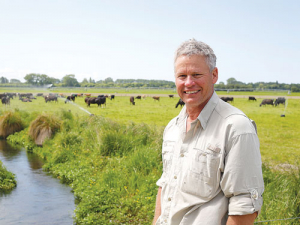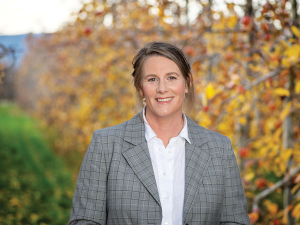A chance remark in the late 1990s got third-generation dairy farmer Andy Palmer started on his labour of love spanning two decades.
That passion has resulted in a legacy of lush riparian planting of native species on his farm near Temuka, which he owns with his wife Sharon Collett.
They’ve suffered lots of of blisters, blunted spades and waterlogged gumboots, and had many visitors admire the work and learn from it.
For Andy and Sharon personally, the net result today is water that’s gin-clear in the arm of the Ohapi Creek meandering past their house on their land. That water quality encourages trout and salmon, attractive vegetation and prolific birdlife.
It began when they took out the traditionally styled garden around their home, replanting it with native species Andy had enjoyed seeing while tramping.
One day, when Andy mentioned he’d like to extend the native garden along the creek, their landscape designer immediately saw he needed help and told him to call Environment Canterbury (ECan), which was then keen to launch riparian pilot projects in South Canterbury. ECan wanted to showcase work that would inform and inspire other farmers.
“Many farmers then saw ECan as bully boys,” says Andy. “However, from the start they’ve been constant in their support. In fact, one weekend some of the staff came out with the local Fish and Game people to help plant.”
Along with hands-on support, ECan connected Andy to sources of funding to help with transforming the creek which, like other waterways NZ-wide had been depleted by many different farming styles – sheep, cows, pigs, and cropping including grass seed, wheat, barley, potatoes, carrots and onions.
Now Andy enjoys the flourishing riparian planting that stretches along 3km of the creek; he adds to this every year either to extend it or grow plants in areas where vegetation is sparse.
Logging the good work
Andy Palmer didn’t document his work much over the years; he just got on with it.
Now he welcomes a recently launched national database of riparian buffer zones nationwide.
Set up by NIWA with DairyNZ’s support, the database will record riparian work by farmers, with the focus on sites more than five years old. So Andy is now recording his work and urging other farmers to do likewise (at riparian.niwa.co.nz).
The information logged will also assist water quality scientists at DairyNZ and NIWA to improve understanding of how riparian buffers benefit waterways, and why some work better than others.
Taking a leaf from Andy's book
A past Ballance Farm Environment Award Best Dairy Farm winner, Andy Palmer has good advice for farmers now starting on riparian buffer zones -- or stalled on the job: “Only do an area you can look after; there’s no point planting thousands of plants if you can’t look after them”.
He recommends identifying areas to plant out and developing a plan to progressively plant, beginning with clearing, especially, willows clogging waterways – he took the digger to his – and then spraying invasive species such as blackberry, gorse and broom.
Using a residual spray that will last 12 months, Andy sprays a circle for each planting.
“This ensures each one gets a good start, and then I use glyphosate around the growing plants to keep the weeds at bay. If weeds get away it can be depressing trying to rescue plants.”
Andy’s farm uses irrigation, and he runs the lines right up near the creek so young plants can be watered if necessary.
In his early riparian days, Andy lost some plants to frosts, and now he selects more hardy species like carex, toetoe, flax and cabbage trees for the first stage, avoiding the broadleaves that don’t survive a freeze.
Other native species he favours include pittosporum, ribbonwood, coprosmas such as mingimingi, and gossamer grass.
His fencing is kept live at all times to deter stock: “Even one or two cows can destroy two years’ work.”
• This article first appeared in DairyNZ publication Inside Dairy March issue.
















